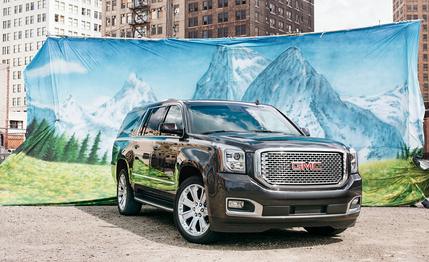
 Long-Term Road Test Wrap-Up
From the November 2015 issue
Long-Term Road Test Wrap-Up
From the November 2015 issue
Deep inside, we’re no different than your average motorhead. We live to thrash sports cars on challenging roads. And for those occasions when two seats won’t cut it, we grab the keys to sports sedans. So what’s up with spending 40,000 miles in an XXXL SUV that’s bigger than many NYC apartments?
Fact is, our transportation needs run the gamut, just like yours. Boxsters and Miatas—vehicles of choice for two-person getaways—are misfits on family vacations. We occasionally move furniture, take camping trips, and shuttle visitors to and from the airport. Some of us avoid our families altogether by spending our weekends at racetracks. Which is to say, sometimes we need something big.
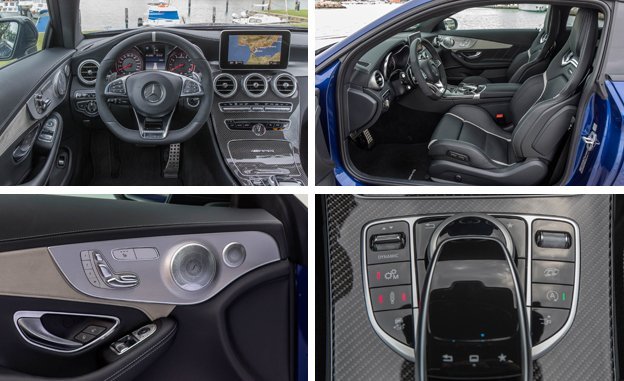
 It has plenty of gadgets, but the Denali's interior feels more like a tarted-up mid-priced truck than a $74K luxury vehicle.
It has plenty of gadgets, but the Denali's interior feels more like a tarted-up mid-priced truck than a $74K luxury vehicle.
Meet Big Den, a 2015 GMC Yukon XL Denali 4WD that casts a shadow twice as large as a Fiat 500’s. Mashing the scales at just over 6000 pounds, this Lone Star limo hauls eight, tows 7900 pounds, and comfortably sleeps a parent and two adventurous kids. Full disclosure: When this 40,000-mile gantlet was complete, we negotiated an extra 8000 miles to accommodate pressing vacation and racing needs.
This is the flagship of GMC’s fleet. Starting with the longer 130-inch wheelbase (versus the regular Yukon’s 116), four-wheel drive, and sumptuous Denali trim, our order monger exercised restraint by adding but two options to the $69,375 base price: a $4160 Touring package (entertainment system with second- and third-row DVD screens, sunroof, theft-deterrent system with self-powered horn, and head-up display) and $495 22-inch wheels.
Most Yukons are sold with Denali trim for good reason: There’s substance behind the geographically disorienting badge. The $16,780 ($16,880 for 2016) upgrade from a base Yukon SLE 4x4 adds a 6.2-liter V-8, heated and cooled perforated-leather front seats, a heated second-row bench, a power-folding third row, magnetic-ride-control dampers, HID headlamps, active noise cancellation, a larger alternator, heated mirrors, a customizable driver’s display, and, last but not least, sparkling exterior body-side moldings.
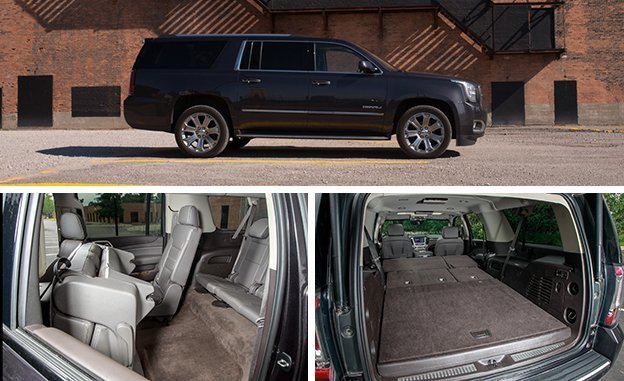
 The Denali's inconveniently high load floor is a consequence of its rudimentary rear suspension. Still, it's awfully roomy.
The Denali's inconveniently high load floor is a consequence of its rudimentary rear suspension. Still, it's awfully roomy.
The heart of the beast is a V-8 that’s closely related to the Chevy Corvette’s LT1 engine. Major features—direct fuel injection, variable intake- and exhaust-valve timing, and cylinder shutdown during light loads—are common to both. The GMC has milder valve timing to skip the Stingray’s nervous idle jitters, which means power is down a touch, but both engines deliver the same 460-lb-ft torque punch. Even though this is a naturally aspirated pushrod design in a world of boosted, multivalve, overhead-cam engines, it’s perfectly suited to the SUV mission, being smooth, reliable, and reasonably fuel efficient. One demerit is that premium fuel is recommended.
After break-in, Big Den clocked a 6.5-second run to 60 mph, 15.1 seconds at 96 mph in the quarter-mile, and a governed top speed of 113 mph. While that’s roughly a dead heat with the last Ford Expedition we tested, the Blue Oval easily beats the GMC’s 70-to-zero-mph stopping distance and 0.75-g (inhibited by stability control) cornering ability. At the 40,000-mile final test, we discovered that launching this rig in four-wheel-drive mode trimmed 0.6 second from both the zero-to-60-mph and quarter-mile-ET figures, moving it toward acceleration parity with the smaller and lighter Mercedes-Benz GL450 three-row transporter.
When it breaks free of parking maneuvers and the ol’ suburban cut-and-thrust, this GMC finds its comfort zone. The longer you drive it, the less its dwelling-sized dimensions annoy you. The V-8 is virtually silent in its work, even when half its cylinders go on furlough to save fuel. We were amazed to see the four-cylinder indicator light up with a loaded trailer in tow at 70 mph, at least on level ground. Our 16-mpg overall mileage tied the aforementioned Benz. Multiply that fuel economy by the 30.9-gallon tank capacity and you’ve got enough range to leap whole states in a single bound.
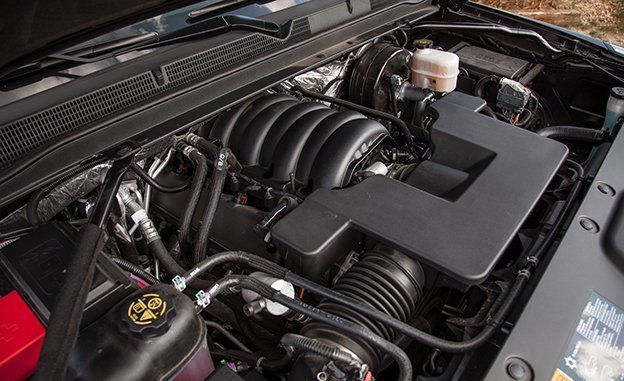

Unfortunately Big Den’s transfer case did not uphold the engine’s impeccable dependability record. One editor inadvertently cycled the ignition button while the driveline was in AUTO (on-demand four-wheel drive) mode, locking the transfer case in 4HI (locked 4WD). According to a service foreman at West Chevrolet in Alcoa, Tennessee, this was a glitch common to all 2015 GM four-wheel-drive pickups and large SUVs. To temporally mend the crow hop caused by turning on dry pavement with four-wheel drive fully engaged, the dealership reflashed an electronic control module.
We waited two months and 6300 miles until our local dealer installed a software fix issued by GM as a “service update.” During this period, we also noticed an intermittent whine that seemed to be coming from the driveline. In fact, this was an electrical noise generated by the transfer-case control module mounted near the accelerator pedal. Thankfully, that annoyance simply disappeared.
Other than that, though, only five other visits to the dealer were necessary over 40,000 miles for tire rotations, inspections, and oil and filter changes. This routine service cost us only $245, less than half the expense of replacing a windshield fractured by debris from Michigan’s war-torn roads. (Two trivial recall fixes—one for adding an A/C-system sticker, a second for correcting owner’s-manual language related to dinghy towing—were installed during the regular service stops.)
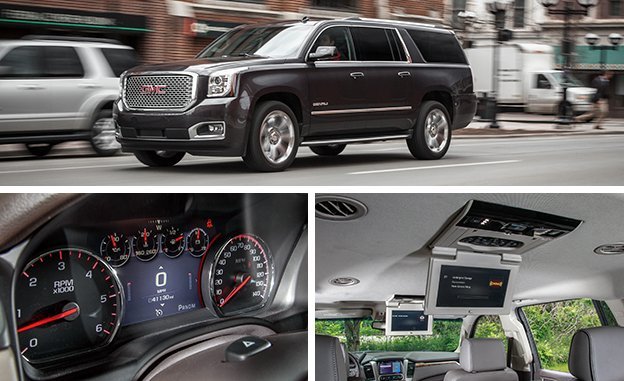
 GMC named this paint color Iridium after the world's second-densest element. That's somehow fitting for this three-ton beast.
GMC named this paint color Iridium after the world's second-densest element. That's somehow fitting for this three-ton beast.
Showing no favoritism to any point of the compass, we enjoyed trips to New York, Texas, and Arizona. Our logbook lists six visits to the Bluegrass State as well as multiple runs to Michigan’s enchanting Upper Peninsula. Driver commentary was, for the most part, complimentary. The 15 beverage holders and six power receptacles were deemed adequate for today’s hard-gamin’, hard-juice-boxin’ kids. The luxury of three separate climate-control thermostats avoided lots of whining. Several did grouse about the offset between the steering wheel and the center of the driver’s seat, but added that this quirk is soon forgotten while driving. The hinge-down entertainment screens obliterate the inside mirror’s view, a problem other makers avoid by offsetting these screens to the side. Third-row headrests also scuttle cop sightlines, but fortunately they can be removed or compressed out of the way. Satellite-radio reception was occasionally missing in action, and the navigation system drove many straight to their smartphones for needed route info. Considering its $74,030 sticker, we found the leather, stitching, plastic, and wood trim underwhelming. Some thought that all the seats were too firm for long-haul comfort, while others rated the front buckets’ thigh support too soft to sustain the Denali’s cornering ability. It takes a village.
Big Den understands the concept of dead-straight-ahead, and its steering held us there with minimal correction. The brake pedal is firm and commendably linear in its delivery of more deceleration for each increment of additional pressure. More amazing: The brake pads took their licking while towing without wearing out; our measurements predict that they will last more than 100,000 miles. The magnetic-ride-control dampers keep the body on an even keel without spanking occupants over bumps and expansion joints. The original set of Bridgestone Dueler H/L Alenza tires powered us safely through the snow season, in part because 22-inch winter tires weren’t readily available.
This truck’s trailer-sway-control programming works in total transparency. Air bladders integrated with the rear dampers level the Denali when towing heavy loads, but we wouldn’t mind a knob on the dash to drop the vehicle for trailer hookup.
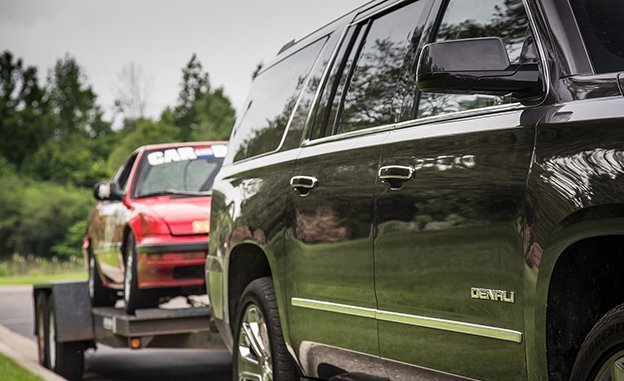
 The Denali's 6.2-liter V-8 proved totally reliable. The same cannot be said of its transfer case or this LeMons race car.
The Denali's 6.2-liter V-8 proved totally reliable. The same cannot be said of its transfer case or this LeMons race car.
The six switches that operate the power-folding rear seats got a serious workout. Two raise and lower the 60/40-split rear row. Four fold and pivot the middle row forward, though erecting that bench is a manual operation. One parent longed for a means of sliding the middle row rearward to stop his kids from kicking the driver’s seat in time with whatever horrid Taylor Swift song was playing.
As part of the 2015 redesign, GMC had added a three-inch spacer to make the rear load floor reasonably flat, if not perfectly level. The result is that every bicycle, suitcase, or anvil you pack into this ute must be lifted three feet off the ground. Also, the new compartment under the cargo floor is largely useless except for transporting pizzas. That said, there’s ample room between the wheelhouses to haul four-foot-wide sheets of building materials like a pro.
Is there a better way to configure the hardworking back half of this vehicle? Nine years ago, GMC ditched a traditional ladder frame to improve the efficiency and flexibility (if not towing ability) of its front/four-wheel-drive Acadia. Ford enhanced the full-size Expedition/Navigator duo by interlacing husky frame members around an independent rear suspension, thereby lowering the cargo floor. We hear from the GM grapevine that an IRS is under consideration for the next generation of mega SUVs, a long-overdue move in our opinion, especially for the luxury-oriented Cadillac and GMC brands.
The wood-paneled wagons that cruised suburbia decades ago evolved into today’s vast selection of haulers ranging in size from Mazda’s CX-3 to our Big Den. Let this be your guide to working your way through the two-box fleet: Buying just enough is always smarter than picking way too much.
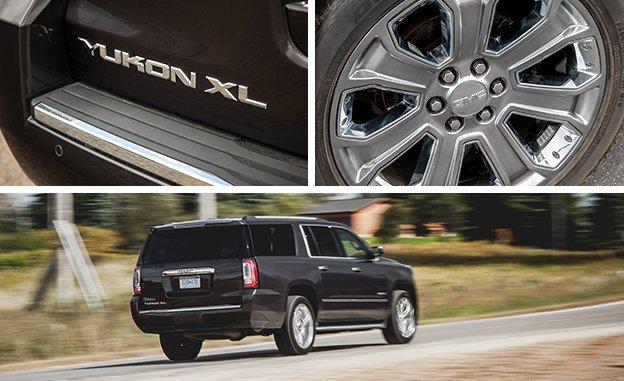

Ron Sessions: The 15 mpg we got while towing 5000 pounds at the speed limit is impressive; so is more than 20 mpg cruising unloaded.
Daniel Pund: Looks grotesque to me, like a beady-eyed brute. Was bothered by the steering wheel’s offset to the left of the driver’s seat only in theory but not in practice.
Jared Gall: Third-row bench seat is like riding on a crate in the bed of a pickup, except for outward visibility, which is blocked by the fattest C-pillar in the business. No wonder rear-most kids plant their faces in tablets, laptops, or the DVD screens.
Rusty Blackwell: Cubbies, bins, and power points abundantly served our four-person household on a trip to Tennessee. At Tail of the Dragon, handling and body control were decent for such an immense beast. Unless the highest allowable gear was manually selected, the transmission tended to be searching on mountain roads.
Jeff Sabatini: Parking poses a problem, prompting me to conclude that this vehicle has crossed the line into too-bigness. Relative to its exterior dimensions, the cargo hold provides little room versus the packaging provided by a Chrysler minivan.
Nathan Schroeder: On long trips, this SUV devours miles in huge chunks, like Kobayashi consuming hot dogs. It’s so large that driving it around town scares the hell out of me.